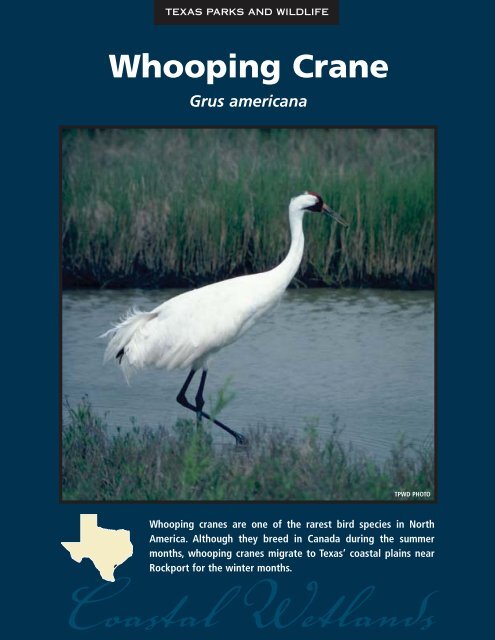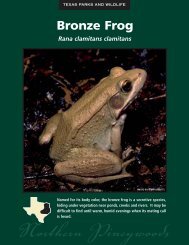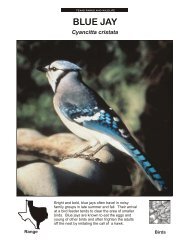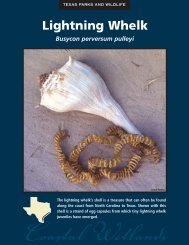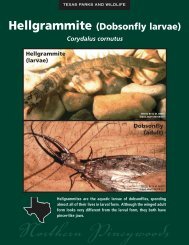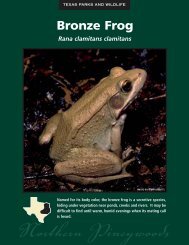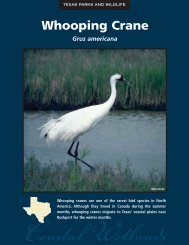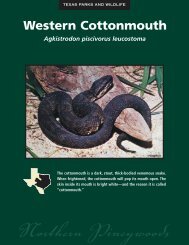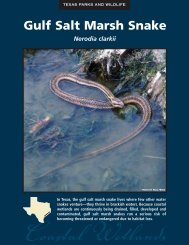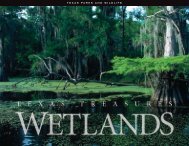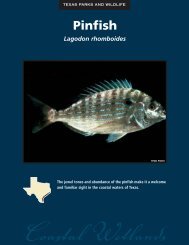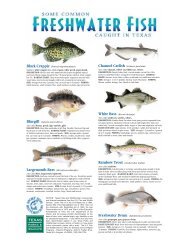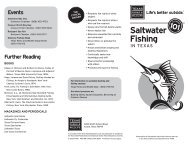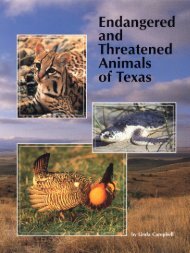Whooping Crane - The State of Water
Whooping Crane - The State of Water
Whooping Crane - The State of Water
Create successful ePaper yourself
Turn your PDF publications into a flip-book with our unique Google optimized e-Paper software.
TEXAS PARKS AND WILDLIFE<br />
<strong>Whooping</strong> <strong>Crane</strong><br />
Grus americana<br />
TPWD PHOTO<br />
<strong>Whooping</strong> cranes are one <strong>of</strong> the rarest bird species in North<br />
America. Although they breed in Canada during the summer<br />
months, whooping cranes migrate to Texas’ coastal plains near<br />
Rockport for the winter months.
<strong>Whooping</strong> <strong>Crane</strong><br />
Grus americana<br />
APPEARANCE<br />
Height: 5 feet (1.5 m)<br />
Wingspan: 7.5 feet (2.3 m)<br />
Distinguishing Characteristics<br />
• White with rust-colored patches on top and back <strong>of</strong> head<br />
• Black feathers on both sides <strong>of</strong> the head<br />
• Yellow eyes<br />
• Primary wing feathers are black but are visible only in flight.<br />
• Long, black legs and bills<br />
LIFE HISTORY<br />
Range: Limited in Texas to the migratory flyway<br />
and coastal plain around Aransas.<br />
Diet: Crabs, clams, crayfish, snails, minnows,<br />
frogs, larval insects and leeches; occasionally<br />
voles, lemmings and shrews;<br />
sometimes acorns and small fruit<br />
Sexual maturity: Between three and five years<br />
Mating season: Early spring<br />
Nest: Made <strong>of</strong> bulrushes about 4 feet (1.2 m)<br />
wide with a flat-topped central mound<br />
up to 5 inches (12 cm) above the water<br />
Eggs: Two<br />
Incubation: 29 to 31 days<br />
Young: Generally, one chick survives. It can<br />
leave the nest while quite young, but is<br />
still protected and fed by its parents.<br />
Chicks are rust-colored when they<br />
hatch; at about four months, chicks’<br />
feathers begin turning white. By the end<br />
<strong>of</strong> their first migration, they are brown<br />
and white, and as they enter their first<br />
spring, their plumage is white with<br />
black wing tips.<br />
Life span: Up to 24 years in the wild<br />
HABITAT<br />
<strong>Whooping</strong> cranes winter on the Aransas National Wildlife<br />
Refuge’s 22,500 acres <strong>of</strong> salt flats and marshes. <strong>The</strong> area’s<br />
coastal prairie rolls gently here and is dotted with swales and<br />
ponds. <strong>The</strong>y summer and nest in poorly drained wetlands in<br />
Canada’s Northwest Territories at Wood Buffalo National Park.<br />
BEHAVIOR<br />
<strong>Whooping</strong> cranes begin their fall migration south to Texas in<br />
mid-September and begin the spring migration north to Canada<br />
in late March or early April. <strong>The</strong>y mate for life, but will accept a<br />
new mate if one dies. <strong>The</strong> mated pair shares brooding duties;<br />
either the male or the female is always on the nest. <strong>The</strong> hatchlings<br />
will stay with their parents throughout their first winter,<br />
and separate when the spring migration begins. <strong>The</strong> sub-adults<br />
form groups and travel together.<br />
NOW YOU KNOW!<br />
• <strong>Whooping</strong> cranes live in “families” with two adult birds, a<br />
male and a female, and one or two <strong>of</strong> their young. <strong>Whooping</strong><br />
cranes migrate more than 2,400 miles a year.<br />
• As many as 1,400 whooping cranes migrated across North<br />
America in the mid-1800s. By the late 1930s, the Aransas<br />
population was down to just 18 birds. Because <strong>of</strong> wellcoordinated<br />
efforts to protect habitat and the birds themselves,<br />
the population is slowly increasing. In 1993, the<br />
population stood at 112. In the spring <strong>of</strong> 2002, it is estimated<br />
that there were 173 whoopers—a small, but important<br />
increase.<br />
• Today, three populations exist: one in the Kissimmee Prairie<br />
<strong>of</strong> Florida, the only migratory population at Aransas National<br />
Wildlife Refuge, and a very small captive-bred population in<br />
Wisconsin.<br />
WHOOPING CRANES AND<br />
PEOPLE<br />
<strong>Whooping</strong> cranes are protected in Canada, the Unites <strong>State</strong>s<br />
and Mexico. Because some <strong>of</strong> their habitat is federally protected,<br />
the land is managed to preserve the animals. <strong>The</strong> greatest<br />
threats to whooping cranes are man-made: power lines, illegal<br />
hunting, and habitat loss. Because the Gulf International<br />
<strong>Water</strong>way goes through their habitat area, the cranes are<br />
susceptible to chemical spills and other petroleum-related<br />
contamination. Public awareness and support are critical to<br />
whooping cranes’ survival as a species.<br />
PWD LF D0200-849A (8/02) NOTICE: Texas Parks and Wildlife Department receives federal financial assistance from the U.S. Fish and Wildlife Service. Under Title VI <strong>of</strong> the Civil Rights Act <strong>of</strong> 1964, Section 504 <strong>of</strong> the Rehabilitation<br />
Act <strong>of</strong> 1973, Title II <strong>of</strong> the Americans with Disabilities Act <strong>of</strong> 1990, the Age Discrimination Act <strong>of</strong> 1975, and Title IX <strong>of</strong> the Education Amendments <strong>of</strong> 1972, the U.S. Department <strong>of</strong> the Interior and its bureaus prohibit discrimination<br />
on the basis <strong>of</strong> race, color, national origin, age, disability or sex (in educational programs). If you believe that you have been discriminated against in any Texas Parks and Wildlife Department program, activity, or facility, or if you<br />
desire further information, please call or write: <strong>The</strong> U.S. Fish and Wildlife Service, Office for Diversity and Civil Rights Programs - External Programs, 4040 N. Fairfax Drive, Webb 300, Arlington, VA 22203, (703) 358-1724.


